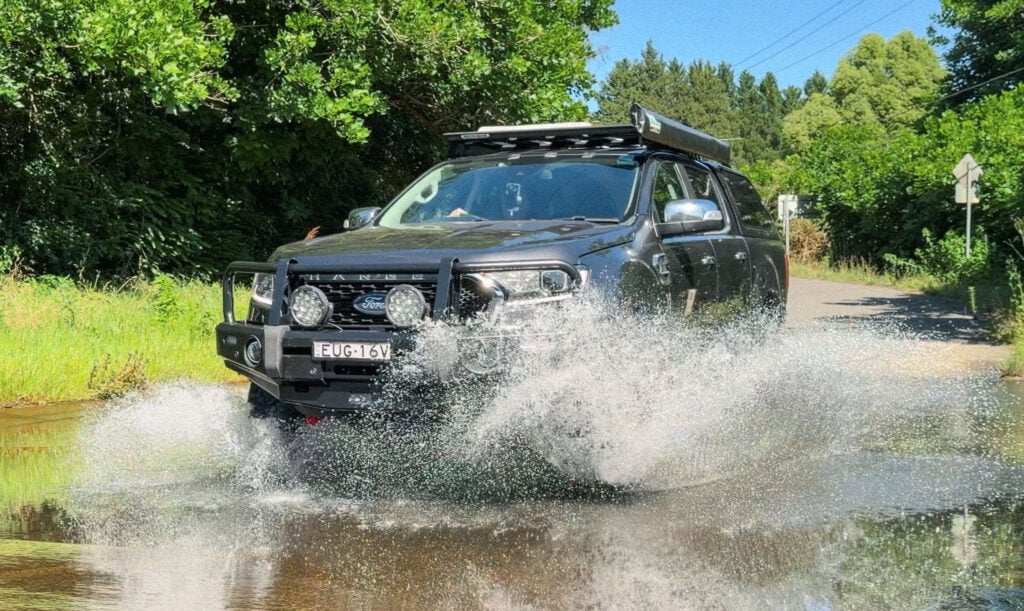THERE IS A CERTAIN thrill about discovering a new road. It starts at home, browsing Google Earth like a US spy satellite, zooming in on especially squiggly stretches to see if they’re sealed or not – or more than a car-width wide. Then there’s deciding to schlep the however many hours out there, hoping to discover it’s 100km/h not 80km/h, that it hasn’t been overrun by crazed trail-seekers in high-riding old Nissan Patrols, or herds of feral deer. Fair dinkum, in the Australian alps that’s very much become a thing.
That could have very well been the case for C486, too, the remote country road connecting Heyfield to Jamieson in Victoria a few hours east of Melbourne, 143km running roughly north-south and reaching 1558m in altitude as it crosses Mount Skene in the Australian alps. A good part of the road is unsealed, and so treacherous in winter (people kept needing to be saved) that it’s now only open seasonally.

An even better part of the road, at least for enjoyment in a low-slung car with softly sidewalled sporty tyres, is mercifully sealed, and that’s the part we’re exploring today. We’re heading from agricultural and timber town Heyfield to Licola, the only town – in all of Victoria – not on the state electricity grid. It is entirely self-sustained.
Given that we are still in some form of lockdown as we set off, our vehicle for self-isolation today at least can guarantee plenty of air-flow. To call the new Porsche 718 Spyder just a pimped-up Boxster would be to do it a gross disservice – and potentially mean you’re missing out on properly appreciating what is a seriously special car.
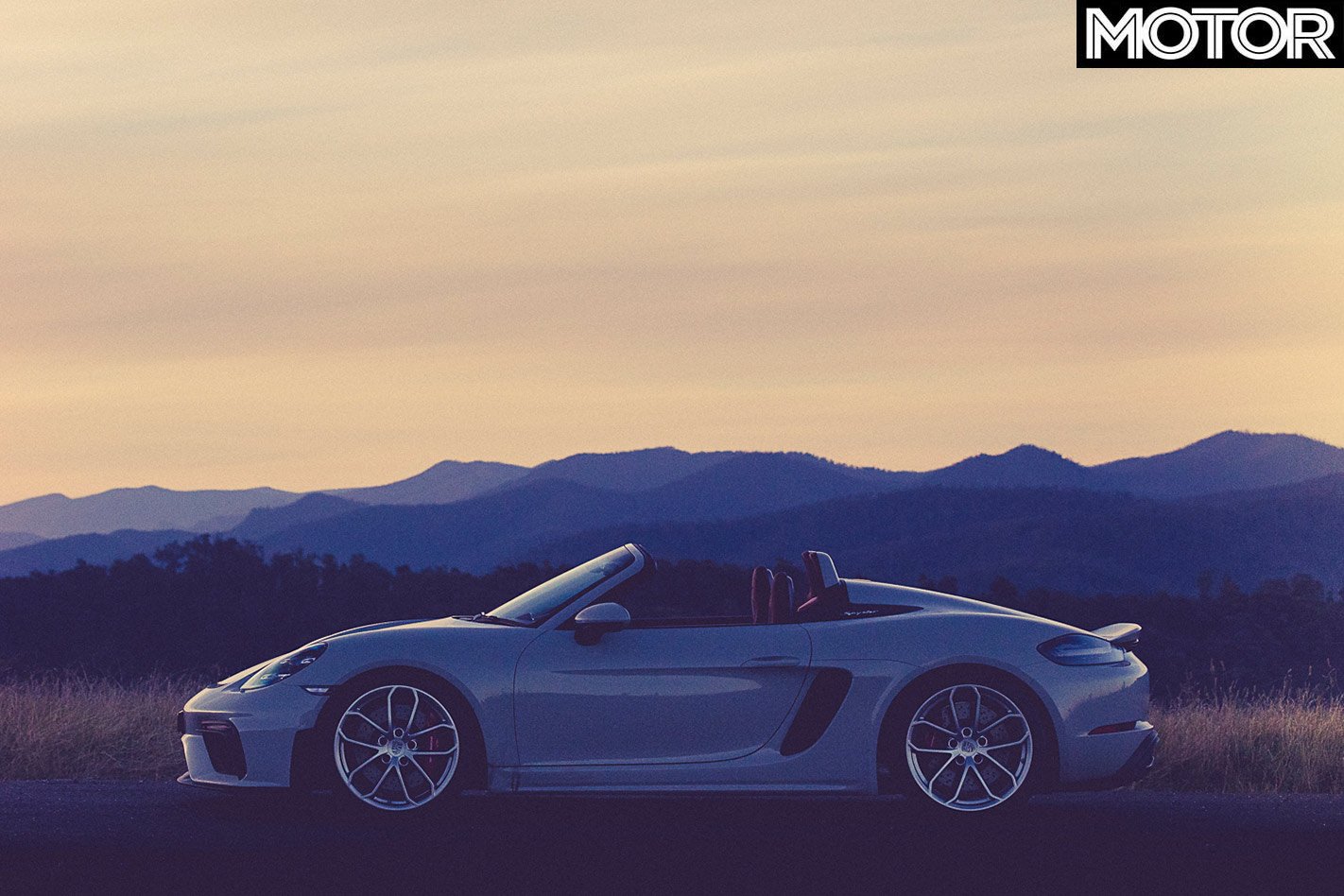
Sitting 30mm lower than a regular Boxster, on enormous, spindly, forged 20-inch wheels; and with low, protruding front spoiler, ducktail-esque rear lip and rear diffuser jutting outwards, the Spyder is visibly the GT3 of Boxsters (from the side profile of the front wheel forward it could be a 991.2 GT3 especially). But this one would be the GT3 Touring if you count the fact there is an H-patterned lever between the seats, no PDK available, not yet anyway.
Always something to be celebrated, the six-speed manual utilises the dual-mass flywheel from the 911 GT3, connecting a newly developed 4.0-litre naturally aspirated flat-six to the rear wheels only, by way of an honest, meat-and-potatoes mechanical limited slip diff. The engine is newly derived from the 3.0-litre 9A2 Evo turbocharged flat-six as seen in the 911 Carreras, but with turbos missing, bore increased by 11mm and stroke by 5.1mm, compression lifted to 13.0:1 and with a redesigned crankcase, dry sump, forged crank, new pistons, conrods, cylinder heads and variable intake. With a maximum engine speed of 8000rpm it’s a fairly serious bit of hardware, peak power of 309kW reached at 7600rpm while 420Nm plateaus across 5000 to 6800rpm. At 3995cc it’s a big engine in a small car, shorter than a Golf and only millimetres wider.

The GT3 treatment continues in the suspension, front and rear subframes pinched from the GT division’s 911 heavy-hitter, along with Weissach-trademark inverted dampers. Solid chassis mounts improve the connection to the standard Michelin Pilot Sport Cup 2 tyres measuring 245/35 front and 295/30 rear. Magnetorheological transmission mounts strengthen that further, electronically firming and softening as the situation demands. The suspension is adjustable for toe and camber and the anti-roll bars for stiffness.
Not that any of that is of any interest to us as we tackle an infamous Spyder quirk, the manually folding roof. With no assemblage of electric motors at your index finger’s beck and call, one must stop the Spyder if they so desire some top-down living. We won’t bore you with the exact process but needless to say, if someone didn’t show you how to do it, you wouldn’t know. It takes about 30 seconds and you only get a bit wet if it’s just started raining.

A positive of the effort required to remove the roof is that the Spyder does encourage you to leave it down for longer than you probably would have if you could just put it up at the press of a button. Which right now we sort of wish we could, now on the move and with the car showing 1.5°C. Fortunately you could cook an egg with the seat heaters and there’s also a steering wheel heater. Just don’t forget your beanie.
Like all great cars, the Spyder feels very right within the first few hundred metres of driving. The seating position is basically spot-on, positioning your hips low and with the 360mm steering wheel (slightly smaller than a standard Boxster) high and facing flat towards you. All the pedals are perfectly judged for their travel, placement and feel, the computer adding revs itself as you let the clutch out, making it very difficult to stall (and if you do, dip the clutch and the engine automatically restarts). The shortened gear lever, meanwhile, is just 16cm from the steering wheel (I measured it) and itself requires barely a movement of the wrist between gears, each ratio slotting with a beautiful, oily, mechanical precision, satisfying enough that you’ll be slowly rowing gears while stationary.
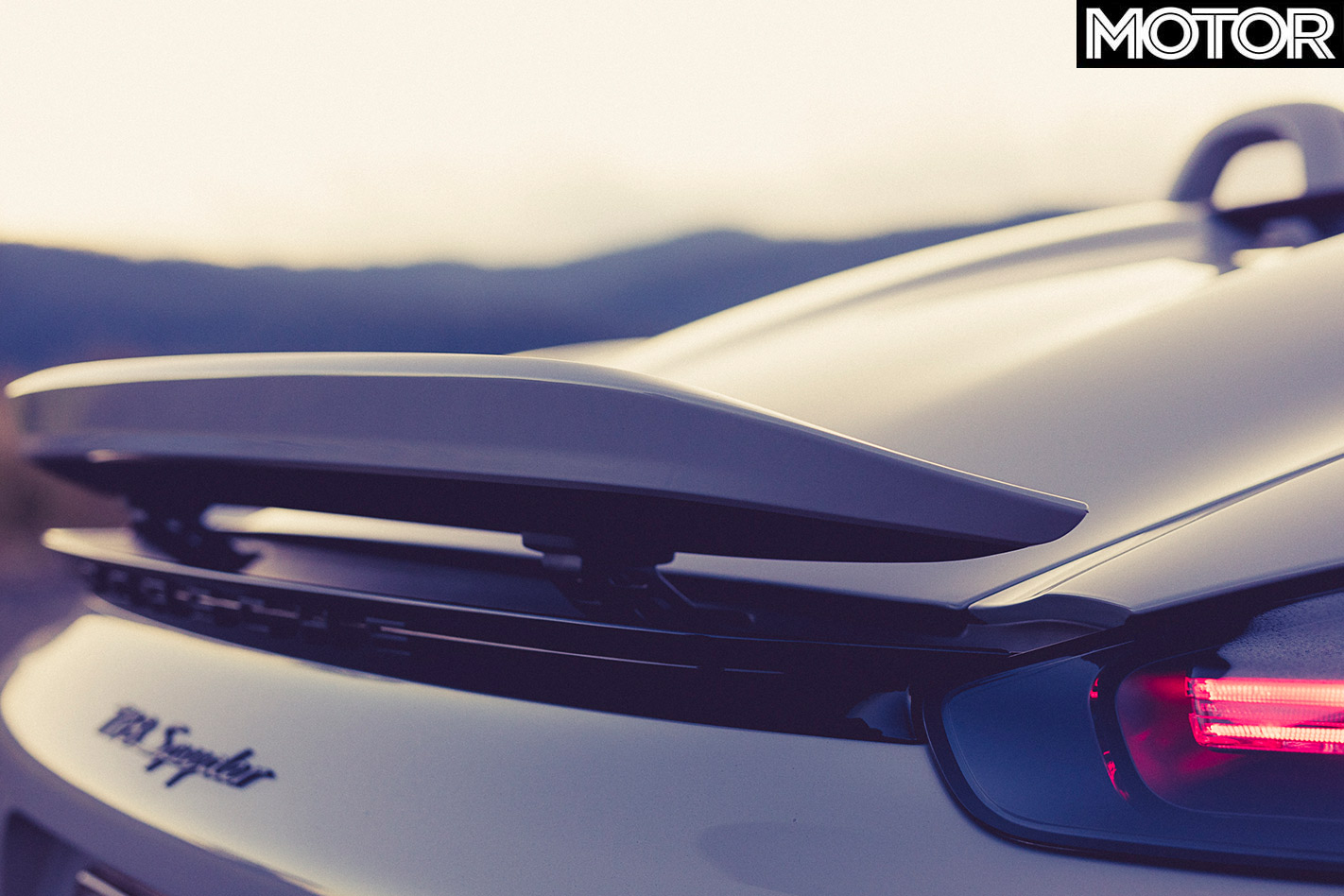
Myself and photographer Ellen having extracted ourselves from Melbourne’s sprawl at an hour caffeine can barely remedy, and heading the two hours’ east to get to the start of our newfound road, we find the Spyder delivers the minimum necessary comfort. Passing B-doubles is deafening even with the roof up, and at other times the tyres roar, especially on coarser chip roads. The stiff ride is not unbearable but certainly sporty. At every part-throttle, cruising opportunity the Spyder’s cylinder deactivation audibly switches to three cylinders. Wind noise with the roof off is actually not bad at all. And the ageing interior is kept modern enough by Porsche’s brilliant touchscreen infotainment system, and with some nice racy GT touches like the black fabric strips for interior door handles.
Thoughts about button tactility and Alcantara quickly fade away as we finally turn on to C486 at Heyfield, smells of woodfire and, well, cows infiltrating the Spyder’s open-topped interior. This part of Victoria is spectacular, and at this time very green, undulating fields working up to hills and with blue-tinted mountains off in the distance hinting at roads to come.

Straight away, the Spyder makes its personality clear by way of the lump of atmo six wedged in its middle. With a throttle so intimately connected to the engine you’d swear it was cable, the Spyder’s 4.0-litre is simultaneously free-revving yet awesomely muscular and flexible for something without turbos. Much has been made about the Spyder and GT4’s gearing and indeed it is on the tall side, first stretching to 82km/h, second 140km/h and 190km/h in third but certainly the engine has got the grunt to pull through them very nicely.
And the engine is truly sensational. At any rpm it’s bristling with willingness and enthusiasm. From low in the revs, flatten the throttle and it pulls cleanly and strongly against the taller gears, motivated by that muscular mid-range until at about 5600rpm when the rate of acceleration steps up another notch, a frenetic and potent surge all the way to the 8000rpm redline. At which point the note has hardened into a loud, very satisfying flat-six roar, all behind you and clear with no roof in the way, with interesting notes of three-cylinder and V12. It’s a noise you could easily imagine coming from out of a supercar let alone a Boxster. Indeed, this engine is going to be unreal with another 1000rpm and in the back of a 911…

While other cars require you to patiently learn the pace of gearchanges to find what is happiest, the Spyder demands nothing but the quickest shifts, the engine so free to rev that it’s like the faster you can put the clutch and throttle in and out and addictively snatch gears across the tight, short gates, the more the car likes it and wants it. It’s an unreal feeling.
Unless you’ve jumped in from a McLaren 600LT you won’t find the Spyder to be lacking acceleration either, Porsche claiming 0-100km/h in 4.4 seconds, 160km/h in 9.0 seconds, 200km/h in 13.8 seconds on to a top speed of 301km/h, roof up or down. The speedo goes to 330km/h.
You’ll want some heat in those 295-section rear Michelins if you’ll be attempting any acceleration figures, it must be said. After an initial, spellbinding fast and open section skirting along the top of a ridge with incredible views of Australia’s geologically ancient mountains, the C486 arrives at what is a long and steady climb up around the side of a hill and then back down again. The Spyder is basically relegated to second gear the whole time, with occasional excursions into third, which would be annoying if not for the engine’s response and brawn, but it does give you one less thing to think about as the sticky Michelins come up to temperature.
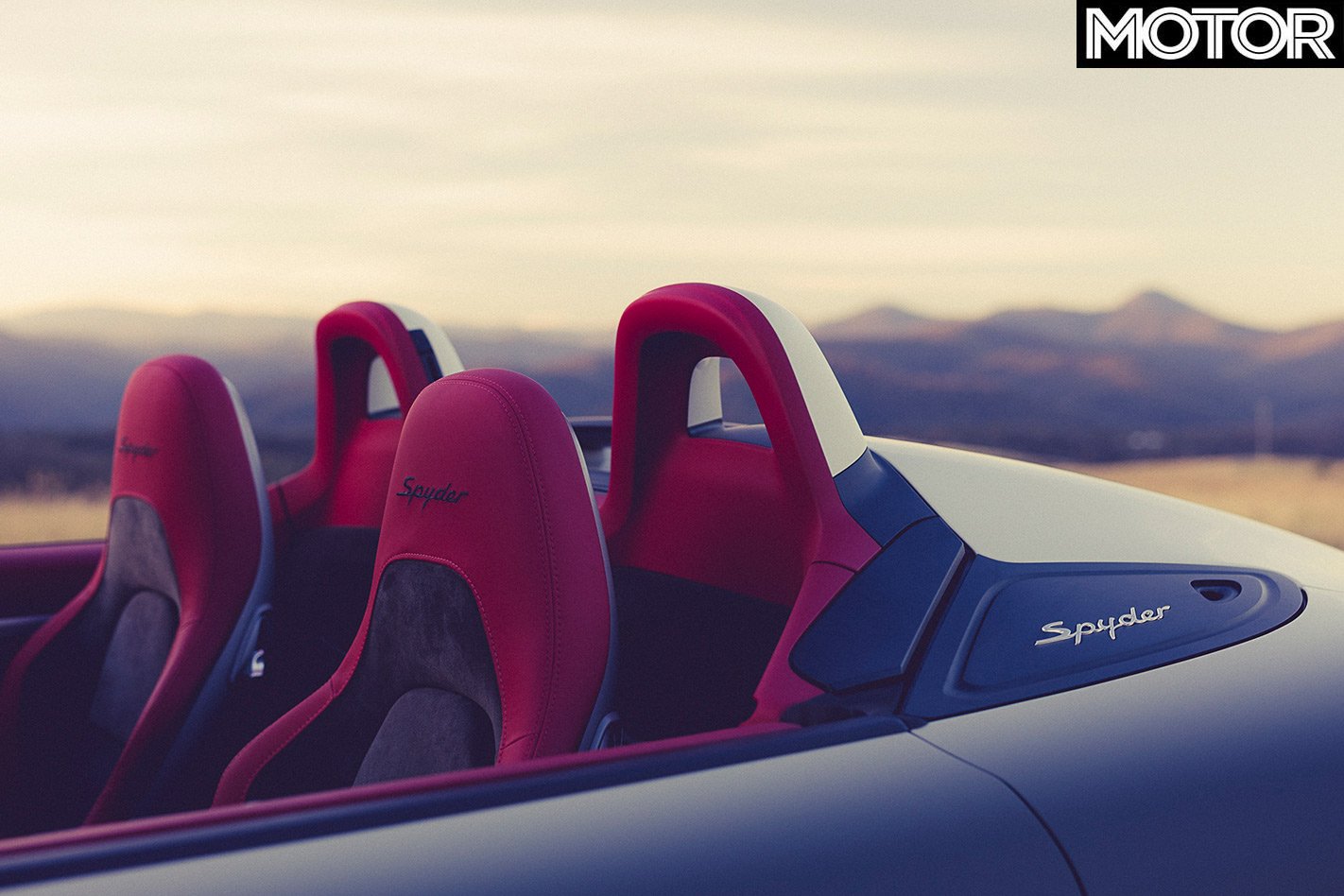
Hints of front end wash, wheelspin and ABS on cold, wet roads earlier in the day turn out to be handling red herrings as the Spyder sinks its fangs into a dry road. The car feels compact and pointy, the steering, while brilliant, not giving you as clear a connection to the front tyres as the throttle does the engine, but enough to give you confidence to push on. The limit of grip, though, just keeps feeling further and further away despite increasingly bold cornering speeds. Understeer reaches a point of being almost impossible, unless you pick up the throttle too early in a corner; throttle steer easily available on exit out of a second-gear corner if you wish. With very little bodyroll, the weight feels low in the chassis, the Spyder revelling in the brakes being held right up to apexes. But beyond that there is just so. Much. Grip. And once the tyres have temperature in them, the limit of braking basically becomes how hard you can push the pedal and how late you dare do so.
Needless to say, the Spyder’s cornering ability is intense, requiring almighty levels of concentration and bravery, but never intimidating or scary. It never feels flustered. It’s an almighty platform and one capable of seriously high cornering speeds. High stakes driving on the road, but fortunately wildlife is likely to be scared off ahead as you can hear the Spyder coming from a mile away.

The Spyder’s towering on-road limits aren’t just your own bravado either it must be said, as if the road isn’t on the smoother side, you soon find yourself holding back for fear of hitting a big bump that unsettles the car. The front end is as low as you can get away with, scraping on driveways (there’s no front-end lifter) but also causing worry about it bottoming out over a big bump at speed. I might get laughed at by a Porsche engineer for thinking that but it was enough to slow me down when the bitumen got a bit choppy. The damper button is no saviour here either, the two modes being very close together.
This is very much a car that would revel to find itself on a racetrack like Phillip Island, where you can properly row through those long gears. Perhaps never has a Boxster had legs this long to stretch. Certainly it would benefit from a shorter diff closing up the ratios; and some more regular performance tyres bringing the limits more into the realm of reality for road driving. But with or without the sticky Pilot Sport Cup 2s, the Spyder is as much baby open-top supercar as it is GT3-ified Boxster. This is definitely a car fast enough to make your passenger very quiet, one in which you have a ‘wow’ moment, a car that finds its way into your memory, and one you’d be very satisfied to have in your garage. To many, the sports car doesn’t get much better than this.
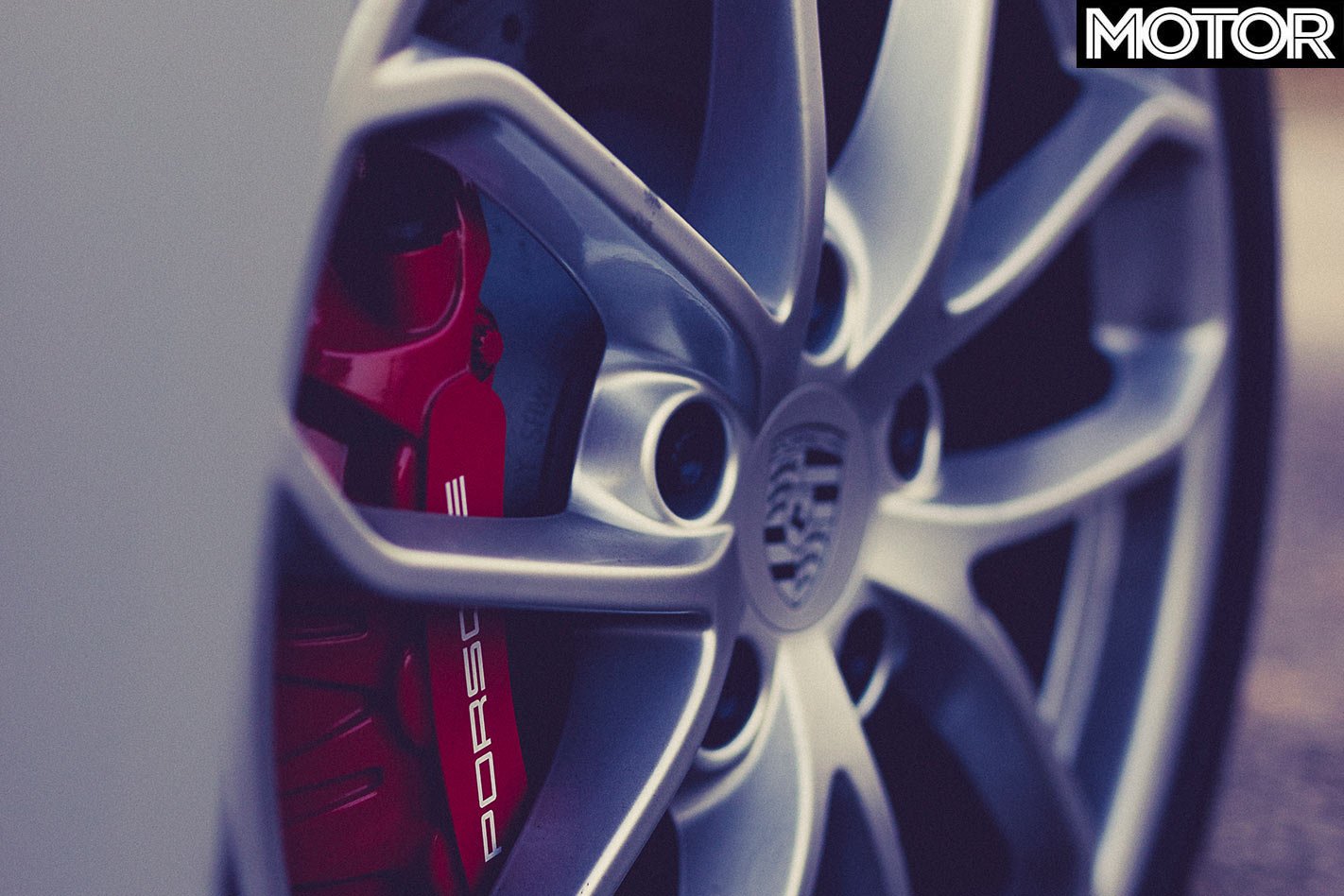
Feeling pensive, we adopt a more relaxed pace as we reach the end of the road, sleepy Licola nestling beside the tranquil Macalister River and a scene completely at odds with the atmo-six-fuelled ferocity experienced just moments earlier. Licola contains not much other than a few houses, a caravan park and a general store, the Spyder looking more than a bit lost amongst some parked-up four-wheel drives. No mobile reception, not even with Telstra, drives the isolated feeling home. If you press on after Licola towards Jamieson, route C486 is even quieter, even more picturesque and just as fun, with the mountains in the distance inviting you to go further. According to Google Earth, however, it becomes gravel not far beyond and you have to turn around. In a car like the 718 Boxster Spyder, that’s a very happy three-point turn. Just watch out for the deer…
2020 Porsche 718 Boxster Spyder specs
| Body | 2-door, 2-seat convertible | u00a0 |
| Drive | Rear-wheel | u00a0 |
| Engine | 3995cc flat-6, DOHC, 24v | u00a0 |
| Bore x stroke | 102.0 x 81.5mm | u00a0 |
| Compression | 13.0:1 | u00a0 |
| Power | 309kW @ 7600rpm | u00a0 |
| Torque | 420Nm @ 5000-6800rpm | u00a0 |
| Power/weightu00a0 | 218kW/tonne | u00a0 |
| Transmission | 6-speed manual | u00a0 |
| Weight | 1420kg | u00a0 |
| Suspension | Struts, coil springs, adaptive dampers, anti-roll bar (f); multi-link, coil springs, adaptive dampers, anti-roll bar (r) | u00a0 |
| L/W/H | 4430/1801/1258mm | u00a0 |
| Wheelbase | 2484mm | u00a0 |
| Tracks | 1538/1534mm (f/r) | u00a0 |
| Steering | Electrically assisted rack-and-pinion | u00a0 |
| Brakes | 380mm ventilated discs, 6-piston calipers (f); 380mm ventilated discs, 4-piston calipers (r) | u00a0 |
| Wheels | 20.0 x 8.5-inch (f); 20.0 x 11.0-inch (r) | u00a0 |
| Tyres | 245/35 ZR20 95Y (f); 295/30 ZR20 101Y (r); Michelin Pilot Sport Cup 2 | u00a0 |
| Price | $197,200 | u00a0 |
| u00a0 | u00a0 | u00a0 |
| PROS | Incredible engine; noise; magic handling; fat stance | u00a0 |
| CONS | Suspension only so compliant; too much grip? | u00a0 |
| Star Rating | 4.5 Stars out of 5 | u00a0 |





